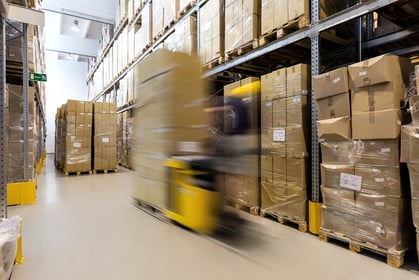The Supply Chain Manager's Guide to Cost Optimization
Nicole Wanichko - March 16, 2021

An optimized supply chain is a key to manufacturing efficiency. It is vital for your supply chain to be running smoothly to ensure you can provide the timeliest and highest quality products possible to this consumer. We have previously discussed why you should optimize your supply chain, but now we will look at this from a management perspective in terms of cost. It should come as no surprise that it can be expensive to run an efficient supply chain that provides visibility and accuracy. Many management executives are so focused on propelling revenue and increasing optimization that they overlook the expenses they are building. There are several considerations to ensure that your supply chain is cost-effective - optimizing your operations without driving up costs.

While cutting costs may sound simple, it can be challenging to manage. As supply chains today are highly complex and interconnected, cutting an expense in one area could be detrimental to another area or increase costs elsewhere. You must look at the entire supply chain and understand the relationship between every step of the process. To begin, we will discuss the primary cost drivers of a supply chain. To cut costs, you must understand what your most significant costs are.
Cost Drivers
Investment Costs
As management, it is essential to know how and when to make business investments to further your company's success and reach. While this is crucial to organizational growth, it can be easy to invest too much in the wrong areas or at the wrong time. There is no way of knowing if all of your investments will be successful, but it's important to invest carefully not to lose too much money at any given time. To make strategic and cost-effective investment decisions, your organization must have an end-to-end view of your supply chain so that you can consider how an investment may affect each step of the supply chain. Additionally, you should have accurate, data-driven forecasts for both the short and long-term to ensure you have and will continue to have ample spending for investments without compromising future goals. It is also essential to have a clear market strategy and expansion plans to align any investments with these goals. Finally, you need the capability to calculate these investment costs so that you can explore "what-if" scenarios and prepare for any losses. Handling strategic investment costs will not only improve the investments you make but ensure that these investments will not compromise your supply chain with unprecedented expenses.
Transportation Costs
Following investment costs, transportation costs are the second-highest supply chain cost driver. While you may not consider these costs to be consequential, they can be very significant for an inefficient supply chain. As transportation is for both finished goods and raw materials, a lot of transportation is required to move these products from supplier to manufacturer to customer. There are also many behind-the-scenes works to coordinate transportation, including planning, routing, and deployment. An error in any of these areas can drastically slow down your transportation, costing you considerably. For this reason, it is paramount that your supply chain runs smoothly so that your transportation operations can as well. To minimize these costs, make decisions about the design of your supply chain to the location of suppliers, manufacturers, distributors, and customers. With this, understand your capacity to utilize as much transportation space as possible and adjust load size accordingly. It is also important to decide the most efficient routes and modes of transport to utilize space and time. An excellent tool for these is transportation optimization software. This software includes a transportation management system (TMS) that will help you manage capacity, track, and monitor all aspects of the transportation process. Additionally, you will be able to model your transportation network to increase visibility, thus ensuring efficiency and reducing unnecessary costs.
Procurement Costs
It is crucial that when choosing suppliers for your organization, you choose one able to deliver the right products at the correct times at the lowest possible price. Whether they are expensive or unreliable, the wrong supplier will drastically increase your procurement costs while lowering your On Time In Full (OTIF) performance and customer satisfaction, so you must avoid them. To minimize these costs, you should be able to use historical and real-time data to evaluate and compare different suppliers' pricing and services. Using this information, choose the most reliable suppliers with the lowest prices and ensure they can deliver the right products at the right time. In optimizing this process, you will make the best possible procurement decisions while reducing costs and improving performance.
Production Costs
For manufacturing companies, in particular, production costs are a substantial supply chain cost. Surges in production costs root from various factors, including inefficient use of equipment and machinery and ineffective workforce management. These factors can drastically increase costs through spiking overtime hours, creating machine malfunctions, and increased production lead times. Production is a sizeable portion of the supply chain, so these inefficiencies slow down production and the supply chain as a whole. To optimize costs, you must improve productivity. To do this, you should make optimized strategic, tactical, and operational plans to manage team member productivity and use of costly machinery, which you can achieve using Artificial Intelligence. AI can optimize your scheduling and network planning and predict maintenance, all of which will help you minimize these costs.
Inventory Costs
 The last major supply chain cost driver is that of inventory costs. Throughout the supply chain, from manufacturers to retails, there is a heavy reliance on inventory. Inventory serves as a buffer against volatility and changing supply and demand so that an organization always has products available. While this is a comforting backup to have, it can also be a great source of costs if your organization carries too much unnecessary inventory. Stockpiling and over-storing inventory can be a significant waste of space, and thus money. In storing this additional inventory, you must pay additional warehouse and transportation fees, which can add up quickly and may not pay off if it is not sold or used. While we do not suggest that you eliminate your inventory, it is good to reduce excess and use forecasting to maintain a reasonable amount.
The last major supply chain cost driver is that of inventory costs. Throughout the supply chain, from manufacturers to retails, there is a heavy reliance on inventory. Inventory serves as a buffer against volatility and changing supply and demand so that an organization always has products available. While this is a comforting backup to have, it can also be a great source of costs if your organization carries too much unnecessary inventory. Stockpiling and over-storing inventory can be a significant waste of space, and thus money. In storing this additional inventory, you must pay additional warehouse and transportation fees, which can add up quickly and may not pay off if it is not sold or used. While we do not suggest that you eliminate your inventory, it is good to reduce excess and use forecasting to maintain a reasonable amount.
Now that you understand the major cost drivers in your supply chain, it is time to manage and minimize these costs. Accurately assess your current supply chain costs through real-time and historical end-to-end supply chain analysis. Using this data and forecasting, you will be able to decipher where you can reduce costs without impacting other aspects of the supply chain. Investing in optimization is expensive, so the first step in making your supply chain as efficient as possible is reducing unnecessary costs. Once you minimize these costs, you will be able to invest in tools that will revolutionize your supply chain and lead your organization to success.
LATEST POSTS
- Understand Circular Economy in The Manufacturing Industry
- How Can Industry 4.0 IT Integration Be Achieved Smoothly?
- The Significance of Order Sequencing in Discrete Manufacturing
- How to improve your Supply Chain Management: The Power of Control Towers
- Optimizing Human Resource Scheduling in Manufacturing: A Technological Approach



